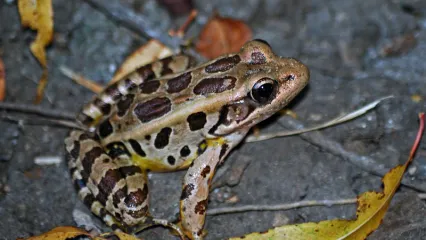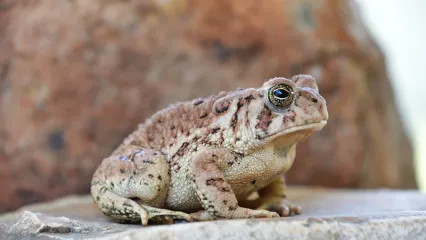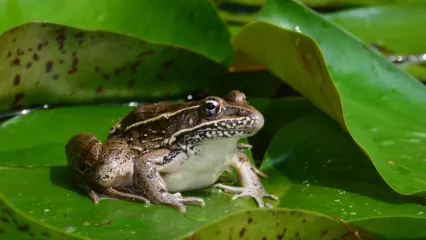
Description
Pickerel frogs are slender-bodied, relatively large frogs that have a unique spotting pattern. The ground color may be tan, brown, or greenish brown with a wide, lighter colored ridge extending from behind the eye to the groin. The back has two rows of large dark brown spots, which in some individuals may be square-shaped. The spots are different sizes and shapes in each individual; in some frogs, several spots may be fused into a long narrow spot. Pickerel frogs can superficially resemble Coastal Plains leopard frogs, although generally the spots on a Coastal Plains leopard frog are smaller and more round. The groin and undersurface of the thigh in pickerel frogs is bright yellow.
Tadpoles of the pickerel frog can reach 2 to 2.5 inches in length before transforming into froglets. The body is globular in shape, and the eyes are located dorsally. The bodies are brown or greenish brown with fine darker brown mottling. The tail and tail fins are mottled with shades of brown. They require at least two to three months before metamorphosis.
The call of the pickerel frog is a low snore. It is often difficult to hear because these frogs breed early in the spring in the same ponds as spring peepers and other Pseudacris, which have loud, high-pitched calls that drown out the sound of the low pickerel frog call. Vocalizations are difficult to localize because pickerel frogs are very wary and quit calling when approached.
Size
Male pickerel frogs are generally much smaller than females. Large females may reach 3.5 inches in length, whereas males typically range in size from 2.0 to 2.5 inches in length.
Habitat
Pickerel frogs are found along small streams or springs in forested areas, including streams in caves in some regions. In the southern part of their range, they occur in swampy or marshy areas and shallow areas of ponds with emergent vegetation.
Life Cycle
In Oklahoma, pickerel frogs typically breed in February, whereas in more northern areas, breeding begins in March. The breeding period is short, extending 4 to 6 weeks, although most breeding occurs during the initial 2 to 3 weeks of activity. Spherical egg masses are attached to fallen branches or other aquatic vegetation. Each mass of eggs may contain 1,000 to 3,000 eggs. The eggs hatch in a few days, and tadpoles require nearly three months to metamorphose.
Like most other frogs, pickerel frogs feed on insects and spiders.
How To Observe
Pickerel frogs are one of the most difficult Oklahoma frogs to observe. Although they may be common in a swampy or marshy wetland, they are secretive and remain hidden most of the time. They do not frequent the edges of ponds during the day like bullfrogs or leopard frogs. Pickerel frogs are difficult to find during the breeding season because their low call is easily masked by vocalizations of frogs with louder calls that breed at the same time.
(This profile was created by Dr. Laurie Vitt as part of a partnership between the Wildlife Department and the Sam Noble Oklahoma Museum of Natural History. It was funded as part of a larger State Wildlife Grant to survey and inventory amphibians and reptiles of the Wildlife Management Areas of Oklahoma: T-35-P-1.)


